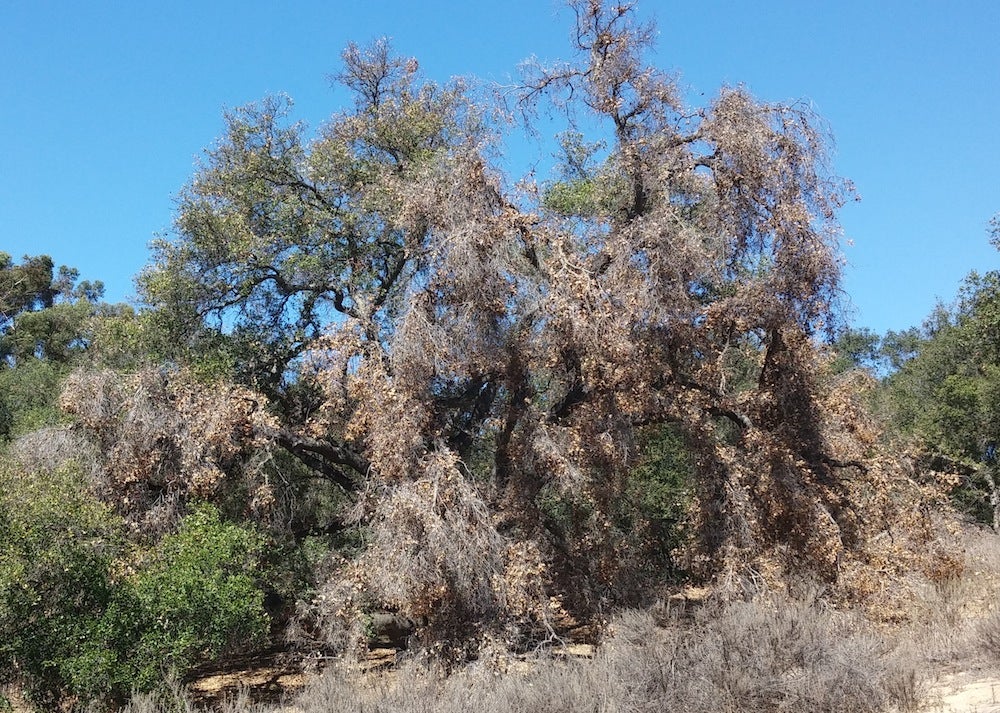
Hot, Dry and Dying



If you want to see how hard California has suffered in the drought and record heat, take a stroll through a stand of oaks. You’ll likely see brown patches in the canopies and dead branches. There’s a good chance you’ll happen on a dead tree, too.
The culprits are record heat and an unprecedented drought, say UC Santa Barbara scientists. For millions of years, oak trees — genus Quercus — have been some of the toughest plants in nature; but even they struggle in soils that haven’t seen significant rainfall since 2011.
“It’s a very hardy, drought-tolerant tree, so it is really a measure of the depth of drought that you’re seeing this kind of dieback,” said Frank Davis, director of UCSB’s National Center for Ecological Analysis and Synthesis (NCEAS) and professor at the campus’s Bren School of Environmental Science and Management.
Oaks aren’t the only trees suffering. Conifers — the state’s pines — are dying by the millions, especially in the southern Sierra Nevada. Bark beetles, which are thriving in the drought, have killed thousands of acres of pines with no end in sight.
The Role of Heat
Periodic droughts in California, with its Mediterranean climate, are nothing new. What sets this one apart, however, is the extreme heat. On Sept. 17 the National Oceanic and Atmospheric Administration (NOAA) reported that August 2015 was the hottest August on record, with global land surface temperatures 2.05 degrees F above the 20th century average. That kind of heat wreaks havoc on the environment.
“The state of the ecosystem in general is strongly tied to temperature,” Davis explained. “Warm the environment and it changes the water use by plants; it can change the population growth rates of insects and pathogens; it changes the rate of decomposition of organic matter; in a nutshell, it changes the metabolism of the ecosystem.”
Dar Roberts, a professor in UCSB’s Department of Geography who has done extensive research with remote sensing of weather, soil and vegetation in California, noted that the heat is only making the drought worse — and harder on the trees.
“What high temperatures mean is a lot of evaporative demand,” Roberts explained. “The atmosphere can uptake lots of water and so the plants can lose a lot of water. That means you have less water to go around and the demand for water is greater, which means the plants are under more stress than they normally would be in a drought.”
Unfortunately, he noted, we might as well get used to it. With climate change cranking up the Earth’s thermostat, he said, heat and drought could be “the new normal. Higher temperatures coupled with drought are likely going to make things worse than they have been in a long time.”
That’s bad news for the trees. The warm, dry conditions have made conifers susceptible to bark beetles, which are normally controlled by cold, snowy winters. The mountains, however, are warming faster than the lower elevations and snowpack the past three years was at the lowest levels ever recorded. “The combination of drought, which lets the beetles get started, plus warmer conditions where their populations can increase faster, lead to this eruption of beetles across the landscape and widespread pine dieback,” Davis explained. “We’re seeing that across many areas of the state now. Millions of trees.”
Dry Down Deep
For the oaks, though, the story of their decline runs deeper — up to 60 feet below ground. That’s the potential root depth of a blue oak (Q. douglasii), the most drought-tolerant of California’s oaks. Even at those depths the soil holds minimal moisture after three years of drought. “The reason you’re seeing the oaks begin to die is that it’s been this gradual drying down of the soil as we continue to not get sufficient rain,” Roberts said.
Roberts has been tracking soil moisture at varying depths through the use of soil moisture probes for several years. He’s seen increasingly dry soils at depths that, in normal seasons, would be wetter the farther down he measured.
“What we’ve found is that our deepest soil layers, the ones about 50 centimeters down, just haven’t gotten much moisture at all in four to five years,” Roberts said. “The last time they got a good soaking was 2011. So then you can imagine these trees. They have these deep roots and they’re tapping these deeper soil layers for moisture. If those layers are not getting replenished by rainfall, and these trees are perpetually drawing more moisture out of them, it’s not good for the trees.”
Not all oaks are created equally, however. Coast live oaks (Q. agrifolia), the most common on the South Coast, are evergreens with shallower roots than deciduous blue or valley oaks (Q. lobata). Both attributes make them slightly less drought-tolerant than the others. The deciduous oaks “can shed leaves in response to drought,” Davis explained. In addition, “the blue oaks are really capable of ratcheting down the water use during hot, dry conditions. They have a way of closing the pores in their leaves so there are lower rates of water loss. All of the oaks do that, but the blue oaks are particularly good at the mechanism of reducing the evaporation of tree canopy back into the atmosphere.”
Looking for El Niño
Despite those adaptations, even the blue and valley oaks are suffering diebacks. The only thing that will stop it is rain. As it happens, help might be on the way. A strong El Niño is building in the Pacific Ocean — NOAA puts the likelihood of such an event at 90 percent — and with it the hope that it could drop large amounts of rain on California as it did in 1982-83 and 1997-98.
But there are no guarantees.
“First, it is not yet as intense as the 1997-98 one,” said Joel Michaelsen, a professor in UCSB’s Department of Geography who specializes in climatology and meteorology. “There is a chance that it will continue to grow and reach a similar magnitude, but that is not at all certain. In any case, there is a better than 50-50 chance that Southern California will have a wetter than average winter.
“The outlook for Northern California, where most of the state’s water comes from, is less certain,” Michaelsen continued. “Besides, the impact of a single year, no matter how wet, will be fleeting. It could potentially improve the state’s water outlook significantly, but there will always be another drought, and rising temperatures will likely make the impact more severe.”
Long Road to Recovery
Even if a wet El Niño arrives, it might not be enough. Roberts noted the rains will be need to be “well-behaved,” dropping large amounts of precipitation and then stopping for a few days to allow the water to percolate into the soil. It will take a series of such storms to penetrate our dry soils, he said. Rain without stop will merely cause runoff and prevent deep percolation.
“If we’ve been sucking the water out of theses soils for three years, and they’re really dry now, this is a huge sponge and it’s going to take a lot of water to refill,” Roberts explained. “And the El Niño might not do it. It might get pretty far, but it may not be able to overcome three years of severe drought. It all depends on how it falls.”
Davis cautions that even perfectly timed rains won’t bring the oaks back immediately. They’re tough, but the damage is extensive. “One thing to consider is that these trees don’t rebound right away,” he said. “It doesn’t happen in days or months. It can take years because they’ve often suffered a lot of canopy dieback and they’ve suffered root dieback and they have to rebuild their root, branch and canopy systems. That may take several years before they’re back to full speed.”



